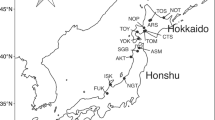Summary
Evidence for hybrid origin of gene-cytoplasmic gynodioecy in Limnanthes douglasii is presented in terms of the parapatric distributions of putative parental taxa and the increased levels of genetic variation in gynodioecious populations. Attempts to produce gynodioecy through artificial hybridization between different accessions apparently failed due to the limited number of parental combinations used in making hybrids. Further studies are proposed on the hybrid origin model and on selective forces determining the fate of gynodioecy with its contributions to higher levels of hybridity and genetic variation.
Similar content being viewed by others
References
Andersen E, Gage A (1952) Introgressive hybridization in Phlox bifida. Am J Bot 39:399–404
Antonovics J, Bradshaw AD, Turner RG (1971) Heavy metal tolerance in plants. Adv Ecol Res 7:1–85
Baetcke KP, Alston RE (1968) The composition of a hybridizing population of Baptisia sphaerocarpa and Baptisia leucophaea. Evolution 22:157–165
Baker HG (1966) The evolution of floral heteromorphism and gynodioecism in Silene maritima. Heredity 21:689–692
Baker HG (1967) Support for Baker's law as a rule. Evolution 21:853–856
Carlquist S (1966) The biota of long distance dispersal. IV. Genetic systems in the floras of oceanic islands. Evolution 20:433–455
Chaplin JF (1964) Use of male sterile tobacco in the production of hybrid seed. Tob Sci 8:105–109
Charlesworth D, Ganders FR (1979) The population genetics of gynodioecy with cytoplasmic-genic male sterility. Heredity 43:213–218
Edwardson JR (1970) Cytoplasmic male sterility. Bot Rev 36:341–420
Endler JA (1977) Geographic variation, speciation and clines. Princeton University Press, Princeton
Godley EJ (1979) Flower biology in New Zealand. NZ J Bot 17:441–466
Goldman M, LoVerde P, Chrisman C (1983) Hybrid origin of polypoloidy in fresh water snails of the genus Bulinus (Mollusca: Planorbidae). Evolution 37:592–600
Gottlieb LD (1972) Levels of confidence in the analysis of hybridization in plants. Ann Mo Bot Gard 59:435–446
Grant V (1971) Plant speciation. Columbia University Press, New York
Heiser CB (1949) Naturalization with particular reference to introgression. Bot Rev 15:645–687
Kesseli RV (1984) Biosystematics, evolution and breeding system analyses in Limnanthes. PhD Dissertation, University of California, Davis
Kesseli RV, Jain SK (1984a) An ecological study of gynodioecy in Limnanthes douglasii (Limnanthaceae). Am J Bot 71:775–786
Kesseli RV, Jain SK (1984b) New variation and biosystematic patterns detected by allozyme and morphological comparisons in Limnanthes section Reflexae (Limnanthaceae). Plant Syst Evol 147:133–165
Kheyr-Pour A (1981) Wide nucleus-cytoplasmic polymorphism for male sterility in Origanum vulgare L. J Hered 71:253–260
Leslie J, Dingle H (1983) Interspecific hybridization and genetic divergence in milkweed bugs (Oncopeltus: Hemiptera). Evolution 37:583–591
Levin DA (1978) The origin of isolating mechanisms in flowering plants. Evol Biol 11:185–317
Levin DA (1983) An immigration-hybridization episode in Phlox. Evolution 37:575–582
Levings CS III (1983) Cytoplasmic male sterility. In: Kosuge T, Meredith CP, Hollaender A (eds) Genetic engineering of plants. Plenum Press, New York, pp 81–92
Lewis H (1961) Experimental sympatic populations of Clarkia. Am Nat 95:155–168
Lewis H, Epling C (1959) Delphinium gypsophilum, a diploid species of hybrid origin. Evolution 13:511–525
Mason CT (1952) A systematic study of the genus Limnanthes R. Br. Univ Calif Publ Bot 25:455–512
Mason HL (1949) Evidence for the genetic submergence of Pinus remorata. In: Jepsen GL (ed) Genetics, paleontology and evolution. Princeton University Press, Princeton
McNeill CI, Jain SK (1983) Genetic differentiation studies and phylogenetic inference in the plant genus Limnanthes (Section Inflexae). Theor Appl Genet 66:257–269
McComb JA (1966) The sex forms of species in the flora of the south west of Western Australia. Aust J Bot 14:303–316
Meyer JR, Meyer NG (1961) Cytoplasmic male sterility in cotton. Genetics 46:883–890
Millar C (1983) A steep cline in Pinus muricata. Evolution 37:311–319
Ornduff R (1971) Systematic studies of Limnanthaceae. Madrono 21:103–111
Ornduff R, Crovello TJ (1968) Numerical taxonomy of Limnanthaceae. Am J Bot 55:173–182
Pearson OH (1972) Cytoplasmically inherited male sterility characters and flavor components from the species cross Brassica nigra (L.) Koch x B. oleracea L. J Am Soc Hortic Sci 97:397–402
Ross MD (1978) The evolution of gynodioecy and subdioecy. Evolution 32:174–188
Stebbins GL, Daly K (1961) Changes in the pattern of a hybrid population of Helianthus over an eight-year period. Evolution 15:60–71
Turner BJ, Brett BH, Miller RR (1980) Interspecific hybridization and the evolutionary origin of a gynogenetic fish, Poecilia formosa. Evolution 34:917–922
Van Damme JMM, Van Delden W (1982) Gynodioecy in Plantago lanceolata L. I. Polymorphism for plasmon type. Heredity 49:303–318
Author information
Authors and Affiliations
Additional information
Communicated by P. M. A. Tigerstedt
Rights and permissions
About this article
Cite this article
Kesseli, R., Jain, S. Origin of gynodioecy in Limnanthes: evidence from ecogeographic patterns of variation. Theoret. Appl. Genetics 74, 379–386 (1987). https://doi.org/10.1007/BF00274721
Received:
Accepted:
Issue Date:
DOI: https://doi.org/10.1007/BF00274721




